There is nothing aesthetically appealing about visible white spots in the area below the eyes. This can be embarrassing and not easily covered up with makeup. The under-eye area is delicate with very thin skin compared to the rest of the face. As you age, this skin becomes even thinner and every flaw or blemish is highlighted in this area. What are these spots and how can you get rid of them? The first step is to identify the spots before attempting removal of any kind.
What Are the White Spots Under Eyes and What to Do?
There are a few options of what the blemishes under the eyes are and the ways to remove them:
1. Milia
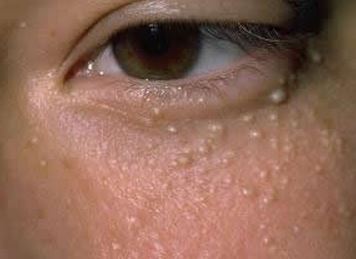 They are also known as milk spots. They are painless, white, tiny cysts filled with keratin (a protein that also makes up hair and nails) and appear commonly around the eyes but can also appear on the nose, chest and forehead. New-born babies often have milia at birth but they resolve spontaneously, often after a few weeks. They are harmless and people of all ages can get them. When adults develop milia, it takes them weeks or even years to disappear. Milia form when pores become clogged with dead skin cells and other debris. These blocked pores can be exacerbated by using an excess of heavy skin care products; certain injuries like burns or rashes to the skin’s pore-lining; or long-term use of steroidal creams.
They are also known as milk spots. They are painless, white, tiny cysts filled with keratin (a protein that also makes up hair and nails) and appear commonly around the eyes but can also appear on the nose, chest and forehead. New-born babies often have milia at birth but they resolve spontaneously, often after a few weeks. They are harmless and people of all ages can get them. When adults develop milia, it takes them weeks or even years to disappear. Milia form when pores become clogged with dead skin cells and other debris. These blocked pores can be exacerbated by using an excess of heavy skin care products; certain injuries like burns or rashes to the skin’s pore-lining; or long-term use of steroidal creams.
What to Do
- Regular facial cleansing using a mild soap with warm water to open pores. The soap should be free of excess fragrances and chemicals. Use a soft towel to gently pat your face dry.
- Gentle exfoliation will release all the trapped debris in your pores. There are some commercial exfoliation treatments available that contain salicylic acid. This product should be applied to the milia directly as frequently as the instruction advises.
- Use a retinol-containing product on the target area. Avoid applying this product too close to the eyes as they can cause irritation if it gets into the eyes.
- Sun protection is important because sun damage can exacerbate milia. When outdoors, wear a hat and facial sunblock. The sunblock should be oil-free and light to prevent further blocking pores with a minimum SPF of 15.
- Stay away from heavy cosmetics even though you are tempted to cover the milia up. These products will only block your pores and delay the disappearance of the milia.
- Popping the milia will be unsuccessful because it is a hard cyst and not a pimple. You will only damage your skin, leaving a scar.
- Lancing these white spots under eyes is another treatment option. A dermatologist can remove the milia without leaving a scar.
2. Syringoma
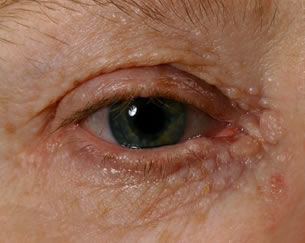 These spots are larger in size when compared to milia. They are usually yellow or skin-colored, and may appear in clusters. They form under the eyes and are caused by an excessive growth of the sweat glands beneath the skin. Syringomas tend to affect women more, especially after puberty. There is a hereditary aspect to this condition and they can appear on the lower eyelids, upper cheeks, forehead, abdomen, armpits and also on the genitals.
These spots are larger in size when compared to milia. They are usually yellow or skin-colored, and may appear in clusters. They form under the eyes and are caused by an excessive growth of the sweat glands beneath the skin. Syringomas tend to affect women more, especially after puberty. There is a hereditary aspect to this condition and they can appear on the lower eyelids, upper cheeks, forehead, abdomen, armpits and also on the genitals.
What to Do
- Removal of syringomas should only be performed by a trained professional like a dermatologist.
- You can prevent the formation of this skin blemish by keeping healthy. Exercise, a balanced diet, no smoking and excess alcohol, sun protection can all prevent the syringomas.
3. Xanthelasma
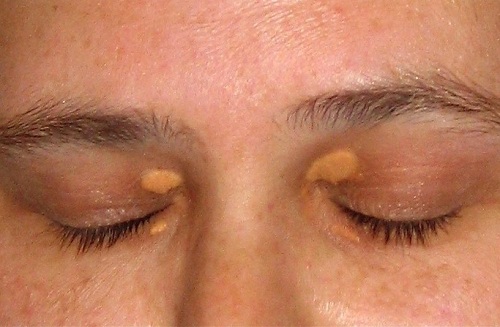 These yellow growths containing fatty deposits can appear on the eyelids and are irregularly shaped. They are caused by high levels of cholesterol in the blood. Over time they can increase in size and number. This condition often affects mostly women over forty. There is also a genetic aspect to developing xanthelasma. People of Asian and Mediterranean descent seem to develop them more than other races.
These yellow growths containing fatty deposits can appear on the eyelids and are irregularly shaped. They are caused by high levels of cholesterol in the blood. Over time they can increase in size and number. This condition often affects mostly women over forty. There is also a genetic aspect to developing xanthelasma. People of Asian and Mediterranean descent seem to develop them more than other races.
What to Do
- See your medical provider first. Your cholesterol levels will be tested and you will be advised on how to get rid of the white spots under eyes. There are some specialized chemical peels that can minimize their appearance.
4. Sebaceous Hyperplasia
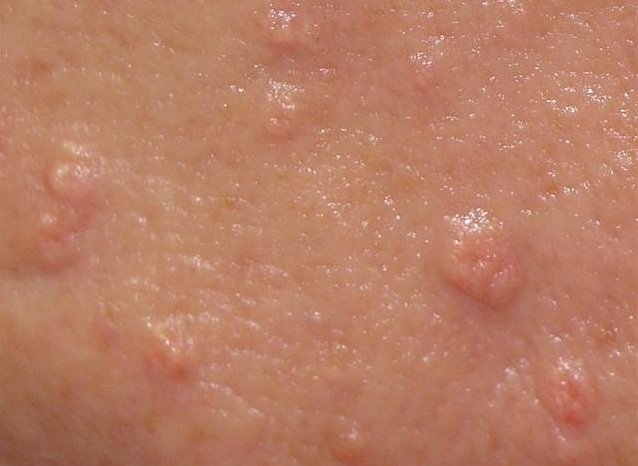 These bumps occur when oil-producing glands become enlarged. They usually affect adults in middle age or older. These soft lesions occur on the face, especially on the nose, cheeks and forehead because of the high number of oil-glands found there.
These bumps occur when oil-producing glands become enlarged. They usually affect adults in middle age or older. These soft lesions occur on the face, especially on the nose, cheeks and forehead because of the high number of oil-glands found there.
What to Do
- Your dermatologist will examine the extent of the sebaceous hyperplasia and choose from a host of treatment options. These may include specialized facial peels, photodynamic therapy, surgical excision, medications both topical and oral.
- Prevent sun damage to your skin because it further harms oil glands.
5. Pimples
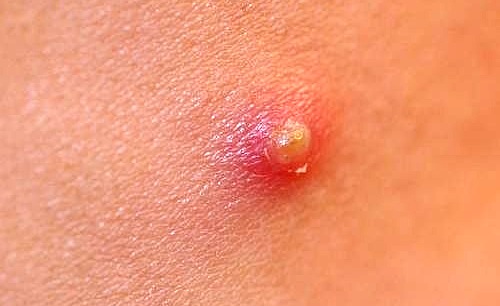 Skin pores can become blocked with dirt, excess oils and bacteria and develop into a spot that fills with pus. Some people have skin that is more prone to blocked pores. Even hormonal fluctuations in women can cause this type of white spots under eyes.
Skin pores can become blocked with dirt, excess oils and bacteria and develop into a spot that fills with pus. Some people have skin that is more prone to blocked pores. Even hormonal fluctuations in women can cause this type of white spots under eyes.
What to Do
- Treatment of pimples around the eye area should be performed with great care because of the thin and delicate skin in that area.
- Keep the face clean by cleansing the area gently and drying with a soft, clean towel.
- Products containing natural antibacterial like aloe vera, green tea, tea tree oil and lavender can reduce the spots under the eyes without excessively drying out the area.
- Avoid heavy makeup that will cause clogged pores which may lead to more pimples.
- Seek medical attention from a dermatologist if the pimples don't clear up.
